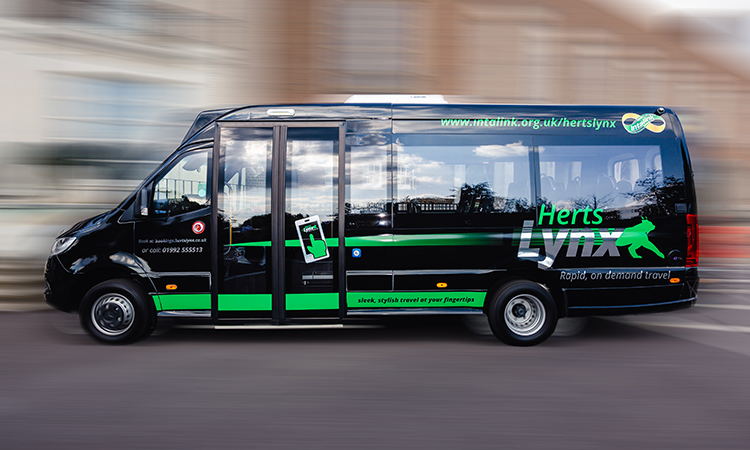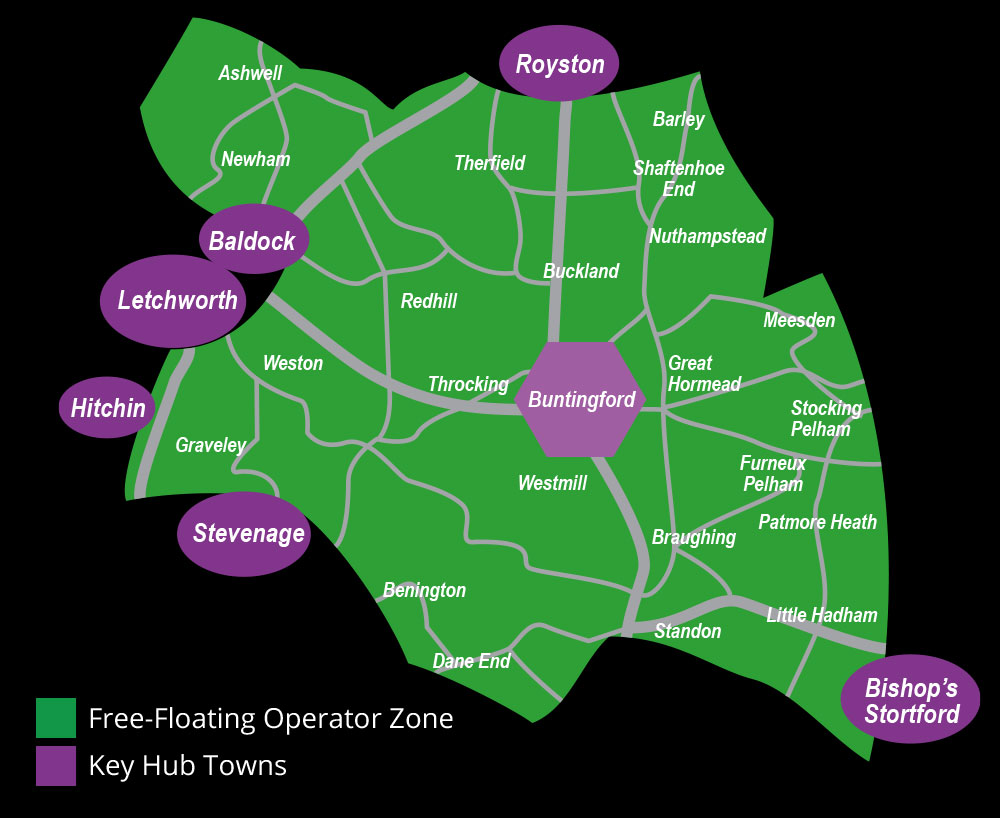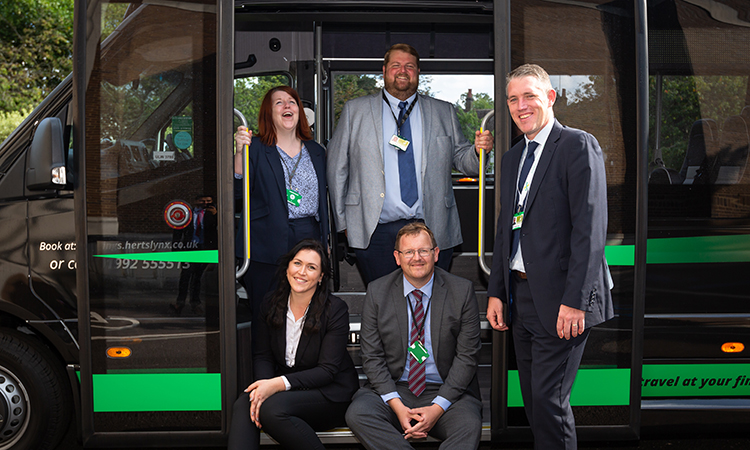Improving transport access in Hertfordshire through the launch of the HertsLynx DRT service
- Like
- Digg
- Del
- Tumblr
- VKontakte
- Buffer
- Love This
- Odnoklassniki
- Meneame
- Blogger
- Amazon
- Yahoo Mail
- Gmail
- AOL
- Newsvine
- HackerNews
- Evernote
- MySpace
- Mail.ru
- Viadeo
- Line
- Comments
- Yummly
- SMS
- Viber
- Telegram
- Subscribe
- Skype
- Facebook Messenger
- Kakao
- LiveJournal
- Yammer
- Edgar
- Fintel
- Mix
- Instapaper
- Copy Link
Posted: 13 January 2022 | Alice Bowler - Hertfordshire County Council | No comments yet
Alice Bowler, Demand Responsive/Community Transport Team Leader at Hertfordshire County Council, tells Intelligent Transport more about the HertsLynx Demand-Responsive Transport service and how it is supporting the Council’s efforts to improve transport accessibility for socially disadvantaged residents and those located in rural areas across the county.


Credit: Hertfordshire County Council
Hertfordshire County Council (HCC) first launched the HertsLynx Demand-Responsive Transport (DRT) service in the north and east of the county on 19 September 2021. It has been implemented by the Intalink Enhanced Partnership, with funding from the Department for Transport’s (DfT) Rural Mobility Fund.
The HertsLynx operating zone is centred around Buntingford and serves all of the villages in a specified area, labelled as the ‘free-floating zone’. Within this zone, passengers are able to travel between over 250 virtual bus stops. The service also provides access to ‘Key Hub Towns’ (KHTs): Stevenage, Royston, Hitchin, Baldock, Letchworth and Bishop’s Stortford; however, travel to these KHTs is limited to hospitals, train/bus stations and high streets.
Improving access to transport
The HertsLynx service directly addresses the challenges faced by transport-disadvantaged groups evaluated in previous county and local plans. The social exclusion of people living in rural areas who have limited or no access to a car or public transport was a key issue identified in the HCC’s Local Transport Plan (LTP). Likewise, Hertfordshire’s Rural Transport Plan (RTP) found that most of rural north and east Hertfordshire face accessibility issues. These prevent socially disadvantaged residents from reaching employment, education, health services and food shopping.
The HertsLynx service is designed to enhance the opportunities afforded to residents in the area of operation by providing easily available transport”
The HertsLynx service is designed to enhance the opportunities afforded to residents in the area of operation by providing easily available transport, both within the scheme area and to six Key Hub Towns that lie just outside of the scheme’s boundaries. Improved access to employment and education, business parks and colleges will improve social inclusion. Previous studies have also highlighted the difficulty of operating cost-effective bus services between geographically dispersed rural villages. These areas are particularly disadvantaged, because commercial bus services tend not to operate in villages far from the primary road networks, where passenger numbers are low, and a bus service is financially unviable. Compounding matters, these communities also lack local rail services.


Credit: Hertfordshire County Council – A map displaying the area of operation for the HertsLynx DRT service.
The benefits of implementing Demand-Responsive Transport services
The key objective of the HertsLynx service is to provide these villages and settlements with either the option of direct links to the county’s key centres or to act as a feeder service to the main inter-urban buses”
Hertfordshire’s RTP and the Intalink Enhanced Partnership/Bus Strategy each concluded that DRT has advantages in providing faster and more direct journeys, offering passengers a one-seat journey where using fixed-route buses alone would require a complex itinerary with multiple transfers. This issue is particularly important in the scheme area’s main town of Buntingford. A council-funded study noted that bus trips between Buntingford and Stevenage are infrequent and particularly circuitous, requiring a transfer and long journey times relative to car travel. The HertsLynx service will be particularly advantageous for journeys from the east of the county to the west, where there is little public transport available, and residents must typically rely on private cars.
The key objective of the HertsLynx service is to provide these villages and settlements with either the option of direct links to the county’s key centres or to act as a feeder service to the main inter-urban buses. By providing shorter wait times and attractive journey times, DRT will become a genuine and more sustainable alternative to private car travel. The DRT solution fulfils several objectives of the Rural Mobility Fund, as well as those of HCC and other local authorities.
Funding, launching and operating HertsLynx
The RMF funding was awarded from the DfT to successful bids from 17 local authorities in March 2021, and HCC was able to bring the HertsLynx scheme from concept to curb side in just under seven months.
After approval, its development began with pre-procurement market engagement with DRT technology providers, leading to HCC making the decision to award separate technology and operator contracts; the technology contract was awarded to Padam Mobility, and the operating contract was won by UNO.
Within the first seven weeks of operation, there were over 2,000 passenger bookings on the HertsLynx service, which is an extremely positive start”
The HertsLynx fleet boasts state-of-the-art Mercedes Sprinter minibuses, purchased from EVM Ltd, which include a specification of USB charging ports, free customer Wi-Fi, luxury seating and are all wheelchair accessible. The service launched with three vehicles in operation; however, two additional vehicles will be introduced to the scheme in Summer 2022, totalling a fleet of five vehicles.
HCC compiled a robust marketing campaign for the pre-launch stage of the project, which ensured that residents understood this new and exciting way to travel before the service launched. This included roadshows, digital and physical campaigns and a VIP press launch event, which was held at County Hall, Hertford, and attended by Stephen Fidler, Co-Director of Local Transport at the Department for Transport.
Bookings for HertsLynx journeys can be made via the HertsLynx app, the booking website or by the dedicated call centre, ensuring that the service is accessible to all demographics.
In conclusion, within the first seven weeks of operation, there were over 2,000 passenger bookings on the HertsLynx service, which is an extremely positive start. The datasets and reporting suites provide clear and instrumental insights into trends within the service and allow for continuous monitoring; this is fundamental to ensure that the service remains aligned with the demand and needs of residents throughout the four-year pilot scheme.
Alice Bowler, Demand Responsive/Community Transport Team Leader at Hertfordshire County Council, has project managed the HertsLynx scheme from concept to curb-side. She has worked for Hertfordshire County Council for three years, leading on multiple transport projects for Adult Care Services and the Integrated Transport Unit. Bowler lead the work to secure the £1.4 million funding from the DfT’s Rural Mobility Fund and will be overseeing the HertsLynx service as it continues to develop within Hertfordshire.
Bowler would also like to give thanks to the HertsLynx Project Team: Andrew Highfield (Head of Integrated Transport Unit), Matthew Lale (Passenger Transport Manager), Dave Hill (Network Planner) and Leanne Melvill (Intalink Coordinator) for the tremendous teamwork that has enabled the Council to launch the service so successfully.


Related topics
Accessibility, Mobility Services, On-Demand Transport, Passenger Experience, Public Transport
Related countries
United Kingdom
Related organisations
Department for Transport (DfT), EVM Ltd, Hertfordshire County Council, Padam Mobility, UNO
Related people
Alice Bowler, Stephen Fidler







